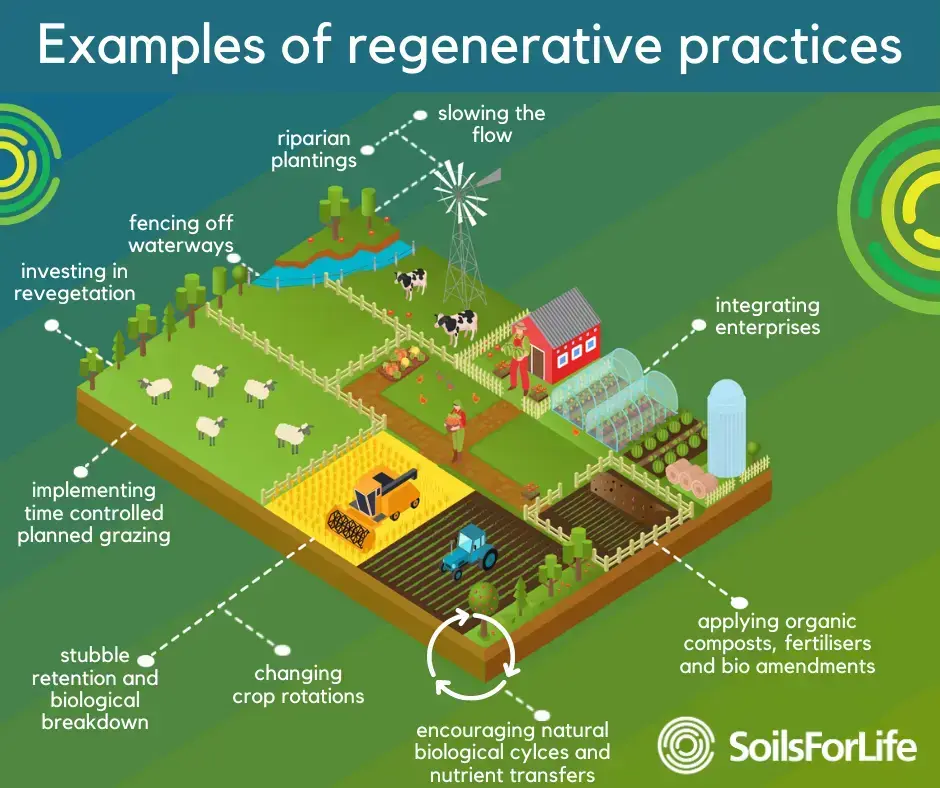Regenerative agriculture is an approach to farming and land management that aims to improve and restore the health of the soil, ecosystem, and the environment as a whole. It goes beyond sustainable agriculture by actively replenishing and revitalizing the resources it uses.
At its core, regenerative agriculture seeks to mimic nature’s intricate and harmonious processes. Instead of relying on conventional practices that deplete the soil and harm biodiversity, regenerative agriculture nurtures the soil, promotes biodiversity, and builds resilience. It encompasses a range of practices, such as cover cropping, rotational grazing, agroforestry, and composting, which work together to restore ecosystem health and vitality.
In recent years, the world has witnessed a growing movement towards sustainable practices across various sectors. One particular area that has gained significant attention is regenerative agriculture. It is an innovative approach to farming that goes beyond sustainability, aiming to restore and revitalize ecosystems while producing nutritious food. As we delve into the year 2023, this article explores the benefits, techniques, and future of regenerative agriculture, showcasing its potential to reshape our food systems and contribute to a more resilient and thriving planet.

Credit: Soilsforlife
Soil Health: The Foundation of Regenerative Agriculture
At the heart of regenerative agriculture lies the recognition that soil health is vital for the sustainability and productivity of our agricultural systems. Healthy soil teems with billions of microorganisms, such as bacteria, fungi, and earthworms, forming a complex web of life. These microorganisms play a crucial role in nutrient cycling, water filtration, and the suppression of pests and diseases.
Research conducted by the Rodale Institute in Pennsylvania, United States, has demonstrated the power of regenerative agriculture in improving soil health. Over a 30-year study, they found that regenerative practices, such as cover cropping, crop rotation, and reduced tillage, significantly increased organic matter content, enhanced water-holding capacity, and improved nutrient availability in the soil. Such practices contribute to the overall resilience of the farming system, making it more adaptable to extreme weather events, reducing the need for synthetic inputs, and ultimately increasing crop yield
Benefits of Regenerative Agriculture
Soil Health Improvement:
Regenerative agriculture practices promote the development of healthy, fertile soils. These practices increase organic matter content, enhance soil structure, and improve nutrient cycling. Healthy soils have higher water-holding capacity, which improves resilience to drought and reduces the need for irrigation. Studies have shown that regenerative practices can significantly increase soil organic carbon (SOC) levels. For example, a 2014 study published in the journal PLOS ONE found that regenerative farming systems increased SOC by an average of 1.3% over conventional farming systems in the United States. Increased SOC helps sequester carbon from the atmosphere, mitigating climate change.
Carbon Sequestration:
Regenerative agriculture has the potential to sequester significant amounts of carbon dioxide (CO2) from the atmosphere and store it in the soil. Healthy soils with higher levels of organic matter act as a carbon sink. According to a meta-analysis published in the journal Agriculture, Ecosystems & Environment in 2019, regenerative agricultural practices can sequester an average of 0.94 metric tons of CO2 per hectare per year. This is equivalent to removing approximately 1,600 cars from the road for a year. Examples of regenerative practices that promote carbon sequestration include cover cropping, crop rotation, and agroforestry.
Biodiversity Conservation:
Regenerative agriculture practices help preserve and enhance biodiversity on farmlands. By promoting diverse crop rotations, cover cropping, and the integration of trees and other vegetation, regenerative farming creates a habitat for a wide range of plants, insects, birds, and other animals. A study published in the journal Agriculture, Ecosystems & Environment in 2020 found that regenerative practices increased bird species richness by 50% and abundance by 90% compared to conventional farming systems. Biodiversity conservation is crucial for maintaining ecosystem resilience and promoting natural pest control, reducing the reliance on synthetic pesticides.
Water Quality and Conservation:
Regenerative agriculture helps improve water quality by reducing soil erosion and minimizing the runoff of sediment, nutrients, and agrochemicals into water bodies. The use of cover crops and reduced tillage helps protect the soil surface, preventing erosion and improving water infiltration. A study published in the journal Agriculture, Ecosystems & Environment in 2018 found that regenerative practices reduced sediment runoff by 90% and nitrate runoff by 85% compared to conventional farming systems. These improvements in water quality have a positive impact on aquatic ecosystems and can benefit human communities that rely on clean water sources.
Resilience and Economic Benefits:
Regenerative agriculture can enhance the resilience of farming systems to climatic variability and extreme weather events. By improving soil health and increasing biodiversity, regenerative practices help crops withstand droughts, floods, and pest outbreaks. A study conducted by the Rodale Institute’s Farming Systems Trial found that regenerative organic systems outperformed conventional systems during drought years, yielding 31% more than conventional systems. Additionally, regenerative practices can reduce input costs over time by minimizing the reliance on synthetic fertilizers and pesticides.
Techniques and Practices to Follow
Cover Cropping: Planting cover crops during fallow periods helps protect the soil from erosion, improves nutrient retention, and enhances soil structure. Examples of cover crops include legumes like clover and vetch, which can fix atmospheric nitrogen, and grasses like rye and oats, which provide excellent ground cover.
Crop Rotation: Rotating different crops in a sequence helps break pest and disease cycles, reduces soil nutrient depletion, and enhances soil fertility. For instance, alternating nitrogen-fixing legumes with nitrogen-demanding crops can naturally replenish soil nitrogen levels.
Conservation Tillage: Reducing or eliminating tillage minimizes soil disturbance, preserves soil structure, and reduces erosion. No-till or reduced-till practices allow crop residues to remain on the soil surface, protecting it from wind and water erosion.
Agroforestry: Integrating trees and shrubs into agricultural landscapes offers multiple benefits. Agroforestry systems provide shade, windbreaks, and habitat for wildlife, while their deep root systems enhance soil structure and nutrient cycling.
Challenges and Limitations
Transitioning from conventional practices: One of the primary challenges of regenerative agriculture lies in the transition from conventional farming methods. Many farmers are accustomed to chemical-intensive practices that have been dominant for decades. Adopting regenerative practices requires a shift in mindset, education, and training. Overcoming resistance to change can be a formidable obstacle to widespread adoption.
Initial investment and profitability: Transitioning to regenerative agriculture often involves upfront costs and a temporary decrease in yields during the transition phase. Investing in new equipment, infrastructure, and education can be financially burdensome for farmers, particularly those with limited resources. The profitability of regenerative agriculture may take time to materialize, making it crucial to provide financial support and incentives to encourage adoption.
Knowledge and technical support: Regenerative agriculture requires a deep understanding of complex ecological systems and holistic farming approaches. Farmers need access to education, training, and technical support to implement regenerative practices effectively. Ensuring that this knowledge is accessible and disseminated widely is crucial for the success and scalability of regenerative agriculture.
Scaling up for large-scale production: While regenerative agriculture has shown great promise on small-scale farms, scaling it up to meet the demands of a growing global population poses a challenge. Adapting regenerative practices to larger farms and industrial agriculture systems without compromising their core principles requires innovative approaches and collaboration between farmers, researchers, and policymakers.
Geographic constraints: Regenerative agriculture practices are highly context-specific and depend on local ecological conditions. Factors such as climate, soil type, and biodiversity can influence the success of regenerative techniques. Implementing regenerative agriculture in areas with limited water resources, extreme climates, or degraded soil can be more challenging, requiring careful adaptation and customization.
Knowledge and research gaps: While regenerative agriculture has gained significant attention, there are still knowledge and research gaps that need to be addressed. Comprehensive scientific studies and long-term monitoring are necessary to understand the full potential, limitations, and best practices of regenerative agriculture. Collaboration between researchers, practitioners, and policymakers is essential to fill these gaps.
Market demand and consumer awareness: For regenerative agriculture to thrive, there needs to be a market demand for regeneratively produced food. Consumer awareness and education are crucial in creating a demand-driven ecosystem that values the environmental and health benefits of regenerative practices. Building consumer trust and communicating the value proposition of regenerative agriculture is essential for its future success.
The Future of Regenerative Agriculture
In 2023, the future of Regenerative Agriculture appears promising, as it gains significant traction and recognition worldwide. The growing awareness of the environmental and sustainability challenges associated with conventional agricultural practices has led to a shift towards regenerative approaches. This holistic and nature-inspired approach focuses on rebuilding soil health, enhancing biodiversity, and promoting ecosystem resilience.
Innovative techniques such as cover cropping, crop rotation, and holistic grazing management are becoming mainstream practices, enabling farmers to restore soil fertility, sequester carbon, and reduce reliance on synthetic inputs. The adoption of regenerative practices is not only beneficial for the environment but also enhances farm profitability and resilience to climate change. With increased research, education, and policy support, the future of Regenerative Agriculture in 2023 holds great potential for transforming the global food system into one that is more sustainable, resilient, and in harmony with nature.








